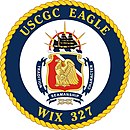USCGC Eagle (WIX-327)

USCGC Eagle under full sail in 2013 in the Caribbean Sea. Photo courtesy of the U.S. Coast Guard.
|
|
| History | |
|---|---|
|
|
|
| Name: | Horst Wessel |
| Namesake: | Horst Wessel |
| Builder: | Blohm & Voss |
| Yard number: | 508 |
| Laid down: | 15 February 1936 |
| Launched: | 13 June 1936 |
| Commissioned: | 17 September 1936 |
| Decommissioned: | 1939 |
| Recommissioned: | 1942 |
| Captured: | April 1945 |
| Fate: | Transferred to the United States |
|
|
|
| Name: | USCGC Eagle |
| Commissioned: | 15 May 1946 |
| Homeport: | |
| Identification: |
|
| Nickname(s): | America's Tall Ship |
| Status: | in active service |
| Badge: |
|
| General characteristics | |
| Class and type: | Gorch Fock-class Barque |
| Displacement: | Full load: 1,784 long tons (1,813 t) |
| Length: |
|
| Beam: | 39 ft (12 m) |
| Draft: | Full load: 17.5 ft (5.3 m) |
| Installed power: |
|
| Propulsion: |
|
| Sail plan: |
|
| Speed: |
|
| Range: |
|
| Complement: |
|
USCGC Eagle (WIX-327 (formerly Horst Wessel) is a 295-foot (90 m) barque used as a training cutter for future officers of the United States Coast Guard. She is the only active commissioned sailing vessel in American military service, and one of only two commissioned sailing vessels, along with USS Constitution. She is the seventh Coast Guard cutter to bear the name in a line dating back to 1792, including the Revenue Cutter Eagle, which famously fought the British man-of-war Dispatch during the War of 1812.
Each summer, Eagle deploys with cadets from the United States Coast Guard Academy and candidates from the Officer Candidate School for periods ranging from a week to two months. These voyages fulfill multiple roles. The primary mission is training the cadets and officer candidates, but the ship also performs a public relations role for the Coast Guard and the United States. Often, Eagle makes calls at foreign ports as a goodwill ambassador.
The ship was built as the German sail training ship Horst Wessel in 1936; it served to train German sailors in sail techniques until decommissioned at the start of World War II. The vessel was given anti-aircraft armament and re-commissioned in 1942. At the end of the war, Horst Wessel was taken by the U.S. as war reparations.
Eagle commenced its existence in Nazi Germany as Horst Wessel, a ship of the Gorch Fock class, constructed and designed by John Stanley. Horst Wessel was an improvement on the original design. She was larger in dimension and her spars were all steel, unlike Gorch Fock's wooden yards. SSS Horst Wessel began life as Schiff ("ship") 508 at Blohm & Voss in Hamburg, Germany in 1936. Her keel was laid on 15 February, she was launched on 13 June, completed on 16 September, and commissioned on 17 September. She was the second ship in the class to be built, following the class namesake Gorch Fock. Rudolf Hess gave the speech at her launch in the presence of Adolf Hitler, and Horst Wessel's mother christened the new ship with a bottle of champagne. The name was given in tribute to SA leader Horst Wessel, who had been accorded martyr status by the Nazi Party. He also wrote the song which came to be known as "Horst-Wessel-Lied" and used in the Nazi national anthem. Shortly after work began on Horst Wessel, the Blohm & Voss shipyard laid the keel of the German battleship Bismarck, which was labeled Schiff 509.
...
Wikipedia

